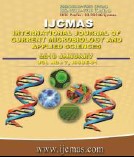


 National Academy of Agricultural Sciences (NAAS)
National Academy of Agricultural Sciences (NAAS)

|
PRINT ISSN : 2319-7692
Online ISSN : 2319-7706 Issues : 12 per year Publisher : Excellent Publishers Email : editorijcmas@gmail.com / submit@ijcmas.com Editor-in-chief: Dr.M.Prakash Index Copernicus ICV 2018: 95.39 NAAS RATING 2020: 5.38 |
Proximate composition of food crops is an essential and inevitable tool to identify their ability to suffice the nutritional security of society. Creating database for the key components of biochemical composition is also an essential step to categorized food crops on nutritional supplanting capacity. Conventionally, for the biochemical characterization was performed with tedious and time consuming proximate and wet methods which did not match with current analytical requirements viz., quick, easy cheap, effective rugged and accurate. Near Infrared (NIR) spectroscopy expected to fulfill the above mention characters. Therefore, a study was performed to determine the analytical efficiency of traditional as well as NIR spectroscopic methods to determine Protein, fiber and oil contentfrom31, 25 and 17 commonly available cultivars of soybean, rice and pigeon pea, respectively. A NIR spectrophotometer (Instalab7200) was standardized with different varieties of above crops as per the protocol. The analytical results obtained with NIR spectroscopic technique was significantly correlated with those from conventional method with high degree of repeatability (% RSD≈10) in results, cost effectiveness and speed of analysis. The outcome of this work indicates that NIR spectroscopy has potential to serve as an accurate and rapid alternative method for quantifying the common biochemical components of different cultivars of soybean, rice and pigeon pea with acceptable accuracy, precision and reproducibility.
 |
 |
 |
 |
 |